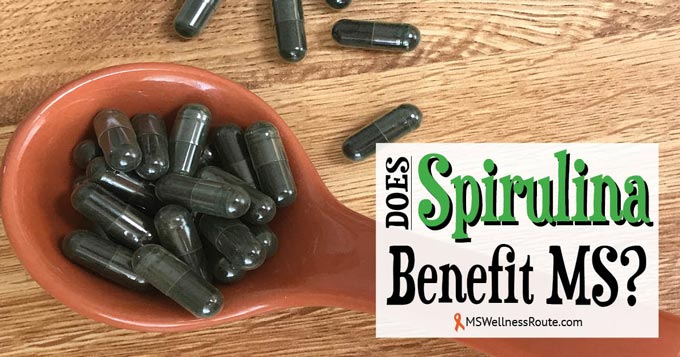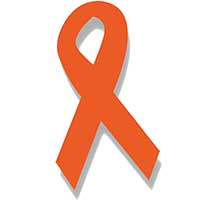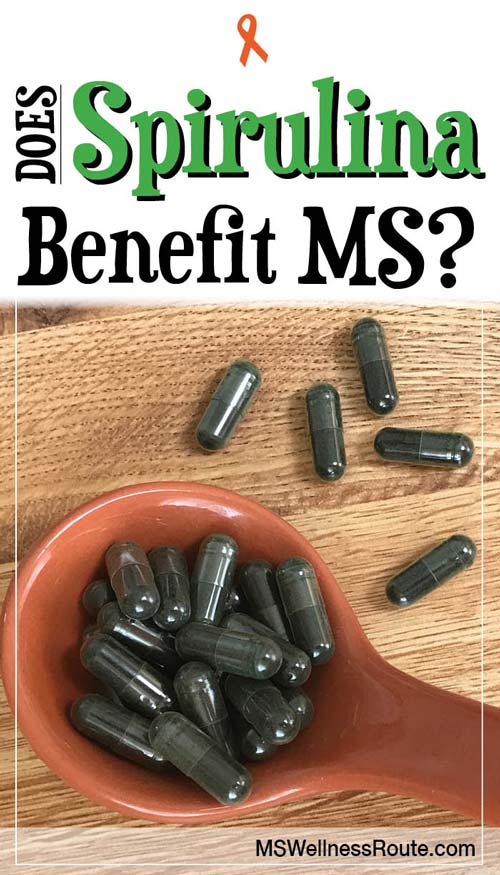Last Updated on November 30, 2023 by Cathy

I’m very happy with the results of my MS symptoms reversing thanks to a Candida/Paleo diet. But, the extreme numbness in my feet won’t go away. My feet went numb about seventeen years ago but I’m determined for them to leave. That’s when I started to research for the most nutrient-dense food on earth and spirulina popped up.
I was definitely intrigued and started looking into more facts. Unfortunately, there’s a lot of conflicting information out there. It makes it confusing as to whether it’s beneficial or not. Some websites claim it’s a “superfood.” Others claim it’s harmful to people with autoimmune diseases. I really wanted to try it but I also didn’t want to harm my body.
What is Spirulina?
Spirulina is a blue-green alga. It’s found in tropical and subtropical lakes, ponds, and rivers. It was a food source for the Aztec civilization in the 16th century. It has an anti-inflammatory ability to stop the release of histamine by mast cells. Plus, it may even have an anti-allergic, anti-cancer, and anti-viral effect.
What are the benefits of spirulina?
Many people consider spirulina a superfood due to its many health benefits. It can detox heavy metals, fight Candida overgrowth, and its brain and heart healthy. It was even used by NASA as a dietary supplement for astronauts during space missions. Candida and heavy metal toxins are possible triggers of multiple sclerosis (MS).
Triggers to MS:
- Poor Diet
- Infections (bacteria, parasites, viruses, and yeast overgrowth)
- Environmental toxins (heavy metals, mold, pesticides, etc.)
- Chronic stress
- Hormones (adrenaline, cortisol, etc.)
Spirulina provides essential amino acids, vitamins, minerals, and proteins. There was a study on 50 undernourished children who ate spirulina along with a local diet. By day fifteen 16 of the children fed spirulina had significant weight gain and improvements. The U.S. National Library of Medicine considers spirulina to be very beneficial. Stating spirulina to be “one of best ingredients for high-quality food supplements.”
Quick Links to Information About Candida:
The Connection Between MS and Candida
How to Tell if You Have Candida
Spirulina Side Effects
After reading all the benefits it makes anyone want to run out and get some. But, before you do that you need to pay attention to the side effects. Not all spirulina comes from a healthy source. Some can contain harmful bacteria and toxic metals. Contaminated spirulina can cause liver damage, weakness, and even death.
Spirulina can also interfere with other medications or supplements. There just isn’t enough scientific evidence to prove whether it is beneficial. Avoid any from Japan because of radiation concerns.
Should I take spirulina?
This is a question I’ve been struggling with for many months. I checked all kinds of websites including Dr. Josh Axe, Dr. Joseph Mercola, and Dr. Terry Wahls. I’ve read it has a high nutritional value and regulates the immune system, which is good.
PubMed’s website states Spirulina protects from demyelination, which is beneficial for MS patients. It’s also great for combating systemic yeast overgrowth, Candida. It encourages the growth of good bacteria in your gut to help keep Candida under control.
I’ve also read over and over that a person with autoimmune diseases shouldn’t take spirulina. It can stimulate the immune system, which is bad. Dr. Sarah Ballantyne and Dr. Andrew Weil advise people with autoimmune diseases to avoid them. It’s so confusing. I still, to this day, don’t know the right answer to that question.
Types of Algae
Dr. Terry Wahls, author of The Wahls Protocol recommends three different types of algae. She also recommends rotating between the three different types of algae. Pay attention to your body, if you’re having bad reactions stop taking them immediately. You may need to take them in the morning if you start having difficulties sleeping.
My Personal Experience
Like I said earlier, I struggled with the decision of whether I should take spirulina. I’ve had really good results being on a Paleo with a combination of a Candida diet and reversing my symptoms. I adjusted both diets to fit my needs.
Most of my MS symptoms have reversed. But my feet and the front of my mouth are still numb, I hate that feeling and would love for the numbness to go away completely. I saw an interview with Dr. Wahls and she said she only eats food that is high in nutrients and she takes spirulina. This is a person who has MS and publicly announced spirulina works for her. That’s why I decided to give it a try.
I took a capsule form because I heard the powder form tasted terrible. You can add the powder form to your smoothie to hide the taste. I wasn’t sure what to expect or if anything drastic would happen.
The. Next. Morning. My hands were a normal color and not red. I can’t even remember the last time my hands weren’t red. I always assumed it was because I’m always cold. Even when it’s hot outside my hands and feet are cold, possibly due to poor circulation. After a few days, I realized my feet were also a normal color and not red.
I was curious why this happened and I couldn’t find anything on the internet. So I contacted my functional medicine doctor. He told me it could be due to the magnesium, minerals, sulfur, protein, or pH of my system. I’m not sure what caused the redness to disappear.
I’m still amazed and all I know is… I Love It!
Do I recommend Spirulina?

I do recommend taking spirulina. It’s rich in nutrients including iron, protein, and vitamin K. It’s also a great detoxifier including heavy metals. There are many warnings about spirulina and autoimmune diseases. However, I haven’t found any solid scientific evidence that proves this claim for people with MS. Thanks to its many health benefits people believe it to be a superfood.
Before taking any new supplement talk to your doctor, supplements can interfere with certain medications.

Free Wellness Library!
Subscribe for free and I’ll send you the password to my secret library filled with many printables for your wellness journey.
Want to Remember This? Save this “Does Spirulina Benefit MS” pin to your favorite Pinterest Board!






